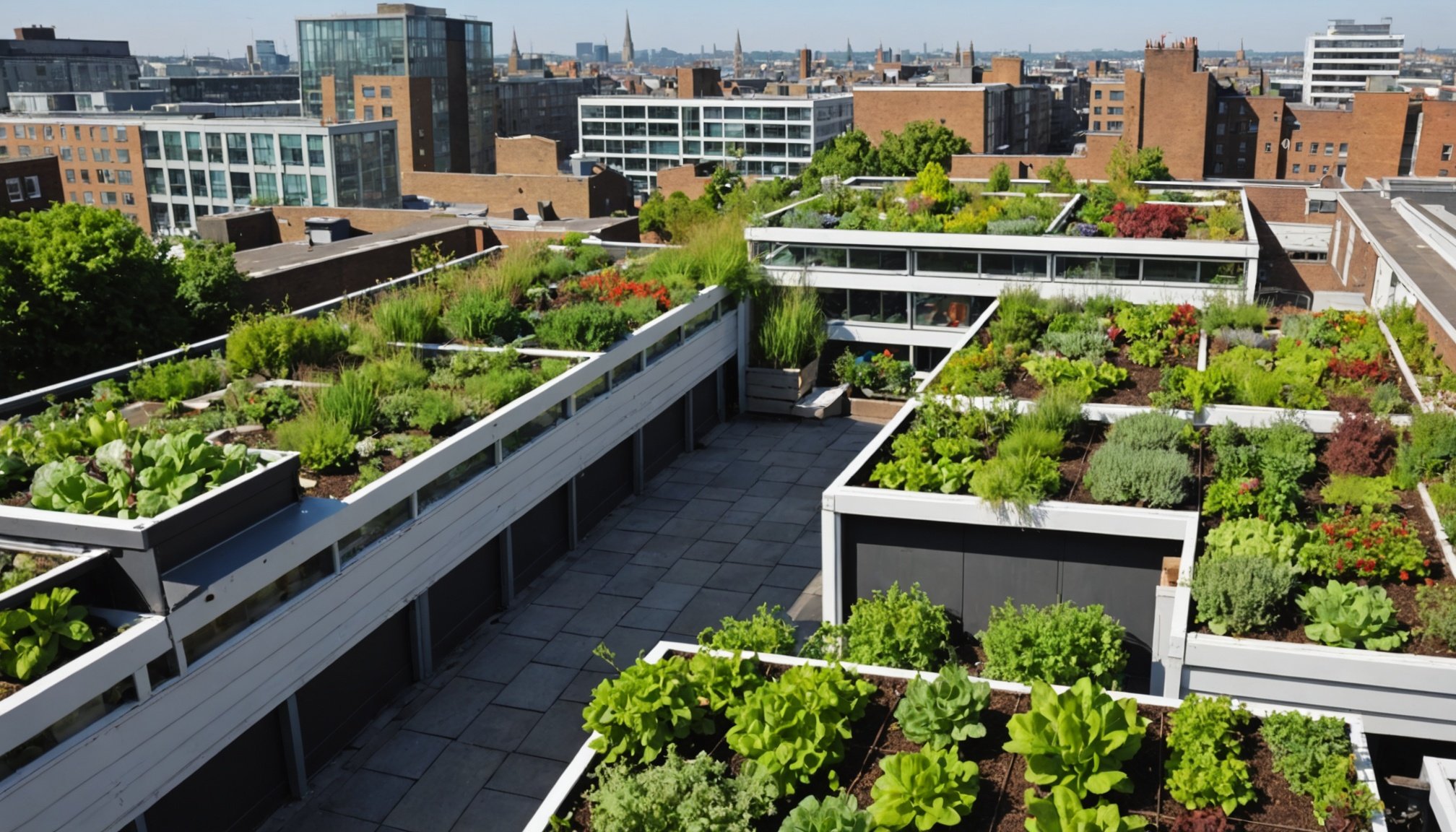The Importance of Rooftop Gardens in Enhancing Urban Biodiversity
Urban biodiversity in the UK faces numerous challenges, such as habitat loss and climate change, which threaten local ecosystems. Rooftop gardens have emerged as a vital tool in combating biodiversity decline by providing essential green spaces in urban environments.
Rooftop gardens play a significant role in mitigating biodiversity loss by offering habitats for various species, such as birds and insects. These gardens create a micro-ecosystem that aids in maintaining ecological balance. By transforming unused spaces into lush, vibrant areas, rooftop gardens contribute to the overall health of urban ecosystems.
Also to discover : Vital guide for uk travelers: how to interact safely with hebrides wildlife
The addition of greenery through rooftop gardens not only supports biodiversity but also helps regulate the urban environment. Plants improve air quality by absorbing pollutants and producing oxygen. Furthermore, they can reduce the urban heat island effect, a phenomenon where city areas become significantly warmer than rural surroundings. This cooling effect is vital in maintaining stable climates for urban biodiversity.
Overall, the implementation of rooftop gardens holds immense potential for enhancing urban biodiversity. By addressing habitat loss and providing ecological benefits, these gardens foster a more balanced relationship between urbanisation and nature. This not only strengthens local ecosystems but also contributes to a healthier urban environment for both people and wildlife.
Additional reading : Connecting the wild: how uk”s wildlife corridors promote species mobility in fragmented ecosystems
Implementation Strategies for Creating Rooftop Gardens
Urban areas can significantly benefit from thoughtfully planned rooftop gardens. Crafting these green spaces begins with careful evaluation and selection of potential rooftops. A structural assessment is critical to ensure roofs can support added weight, including soil and water retention systems. Once a suitable space is identified, advancing to design and plant selection is key.
Selecting the right plants is crucial for maximising biodiversity. Opt for a variety of native plant species, as they better support local wildlife. Such plants are adapted to local conditions and encourage diverse ecosystems by attracting pollinators and other beneficial species.
Sustainable gardening techniques are vital to maintaining healthy ecosystems atop rooftops. Consider incorporating eco-friendly elements like rainwater harvesting systems to reduce water usage. Organic soil and natural fertilisers can boost plant health while minimising environmental impact.
A successful rooftop garden is not only lush and resilient but also provides measurable ecological benefits. By incorporating careful planning, selecting appropriate plants, and implementing sustainable practices, urban gardeners can create thriving ecosystems that enhance both local biodiversity and the well-being of city environments. This methodical approach can transform urban spaces into vital habitats for various species.
Successful Case Studies of Rooftop Gardens in UK Cities
Throughout the UK, case studies of thriving rooftop gardens illustrate their potential impact on urban biodiversity. A prime example is the Queen Elizabeth Hall Roof Garden in London, which serves as a model of ecological benefits and community engagement. This garden not only creates a lush habitat for urban wildlife but also engages the local community in gardening projects.
Building on this, the Phipps Conservatory’s Center for Sustainable Landscapes showcases how community-led initiatives can enhance biodiversity. By integrating native plants and eco-friendly features, they have created a self-sustaining ecosystem. Such projects highlight the importance of community involvement in fostering environmental responsibility.
The success of these urban gardening projects rests on lessons learned from earlier initiatives. Key insights include the necessity of sustainable maintenance practices and tailored plant selection to support diverse wildlife.
Across the UK, these examples underscore the significance of innovative urban gardening in transforming cityscapes. They reveal how strategic collaboration between local authorities, residents, and environmental experts can drive positive ecological change. Urban gardeners continue to apply these insights, furthering efforts to incorporate more green spaces into densely populated areas, thus benefiting urban biodiversity immensely.
Challenges and Solutions in Rooftop Gardening
Rooftop gardening in urban areas presents specific challenges, particularly in densely populated UK cities, where space and environmental factors play crucial roles. A common challenge is structural limitations; rooftops must withstand additional weight from soil, plants, and water collection systems. The solution here involves conducting thorough structural assessments to ensure building integrity, followed by employing lightweight soil substitutes and efficient irrigation systems.
Climate conditions present another obstacle, as rooftops face exposure to extreme weather, including high winds and temperature variations. To mitigate these effects, urban gardeners can select hardy, drought-resistant plant species and incorporate windbreaks or shelters.
Water management also poses a significant concern. With increasing urbanisation, efficient water use is vital. Implementing rainwater harvesting systems and utilising drought-tolerant plants can reduce dependency on municipal water supplies, addressing this challenge effectively.
Community support and education are essential for overcoming these hurdles. Engaging residents through workshops or initiatives enhances shared responsibility for garden upkeep, fostering sustainable practices. Benefits extend beyond individual projects, supporting urban biodiversity and improving quality of life within city environments. These solutions underscore the potential of rooftop gardens to transform urban landscapes, encouraging increased adoption among city planners and residents alike.
The Future of Rooftop Gardens and Urban Biodiversity
As urbanisation progresses, the future of rooftop gardens holds significant promise in enhancing urban sustainability and promoting biodiversity initiatives. Emerging trends indicate an increased interest in integrating these gardens into city planning, driven by the necessity to create more harmonious urban environments. A major trend involves the application of technology to develop innovative methods for maintaining and enhancing rooftop ecosystems. This includes smart irrigation systems that optimise water use and drones for monitoring plant health.
These advancements contribute to better resource management, which is crucial in densely populated areas where resources are often scarce. Urban biodiversity efforts are also gaining momentum, with city planners looking to incorporate more native plants, which support local wildlife and reduce maintenance needs.
Long-term benefits of rooftop gardens extend beyond immediate ecological gains. They can significantly enhance the quality of life in cities by increasing green spaces, which are linked to improved mental health and community well-being. Moreover, they play a crucial role in educating urban residents about sustainability and environmental responsibility.
The continued commitment to these initiatives has the potential to reshape urban landscapes, fostering cities that are not only more environmentally friendly but also more attractive and livable places for future generations.
Design Tips for Maximizing Biodiversity in Rooftop Gardens
Incorporating thoughtful design tips can turn any rooftop garden into a thriving habitat for enhancing biodiversity. Firstly, create diverse plant selections. This involves mixing native plant species with different flowering periods to provide continuous food sources throughout the year. This plant diversity supports urban wildlife and promotes a balanced ecosystem.
A crucial element is the inclusion of water features and natural elements. Small ponds or birdbaths can attract various species, providing necessary hydration and refuge. These features not only enhance biodiversity but also add visual interest and tranquillity to garden aesthetics.
Designing with sustainability in mind is paramount. Integrate materials that are eco-friendly and durable, reducing environmental impact while ensuring garden longevity. Accessibility should not be overlooked. Paths and seating areas that are easy to navigate encourage community interaction and engagement with nature.
By prioritising these design tips, rooftop gardens can become vital urban havens that support local ecology and offer residents a refreshing escape from city life. Furthermore, these considerations promote sustainable practices and inclusivity, making rooftop gardening an attractive option for urban revitalisation efforts. Through strategic planning, these green spaces contribute significantly to biodiversity efforts across urban landscapes.
Benefits of Rooftop Gardens for Biodiversity
Rooftop gardens offer significant ecological benefits by creating habitats for urban wildlife. They serve as green sanctuaries within cityscapes, supporting a diverse array of species. By integrating rooftop gardens, urban areas can witness an increase in local biodiversity as they provide essential food sources and shelter for pollinators and small animals.
These gardens also play a crucial role in improving air quality. Plants naturally absorb carbon dioxide and other pollutants while releasing oxygen, resulting in cleaner and fresher air. This function is vital in urban environments, where pollution levels are often higher.
Moreover, rooftop gardens help to mitigate the urban heat island effect, a phenomenon where urban areas experience higher temperatures than surrounding rural areas. The cooling effect provided by green roofs reduces the need for artificial cooling, subsequently lowering energy consumption.
In addition to these direct ecological benefits, rooftop gardens contribute to urban aesthetics and wellness. By enhancing green spaces, they offer a peaceful retreat for city dwellers, boosting mental health and fostering community interaction. Ultimately, the integration of rooftop gardens supports urban ecosystems and enriches the living environment for both humans and wildlife.









